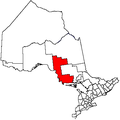| People | Ojibwe |
|---|---|
| Treaty | Robinson Huron |
| Headquarters | 195 Village Road, Cutler |
| Province | Ontario |
| Land [1] | |
| Main reserve | Serpent River 7 |
| Land area | 108.79 km2 |
| Population (2024) [2] | |
| On reserve | 375 |
| On other land | 27 |
| Off reserve | 1219 |
| Total population | 1621 |
| Government [3] | |
| Chief | Wilma Johnston |
| Council | Shirley Ahwanaquot Kerri Commanda Richard Measwasige Michelle Owl John Trudeau |
| Tribal Council [4] | |
| Anishinabek Nation Mamaweswen, The North Shore Tribal Council | |
| Website | |
| https://serpentriverfn.com/ | |
Serpent River 7 | |
|---|---|
| Serpent River First Nations Reserve No. 7 | |
 | |
| Coordinates: 46°11′N82°33′W / 46.183°N 82.550°W | |
| Country | |
| Province | |
| District | Algoma |
| First Nation | Serpent River |
| Area | |
| • Land | 79.03 km2 (30.51 sq mi) |
| Population (2011) [5] | |
• Total | 373 |
| • Density | 4.7/km2 (12/sq mi) |
| Website | serpentriverfn.ca |
The Serpent River First Nation (Ojibwe : Genabaajing Anishinaabek), [6] a signatory to the Robinson Huron Treaty of 1850, is an Anishinaabe First Nation in the Canadian province of Ontario, located midway between Sault Ste. Marie and Sudbury along the North Channel of Lake Huron.
Contents
The First Nation's provisional territory extends from this waters of the North Channel of Lake Huron, Serpent River Basin; north beyond the city of Elliot Lake. [7] The Serpent River nation has a provisional land base of 5250 square kilometers. [8] It occupies the Serpent River 7 reserve.
The First Nation was impacted significantly by uranium mining at Elliot Lake, including through contamination of the Serpent River. [9]

